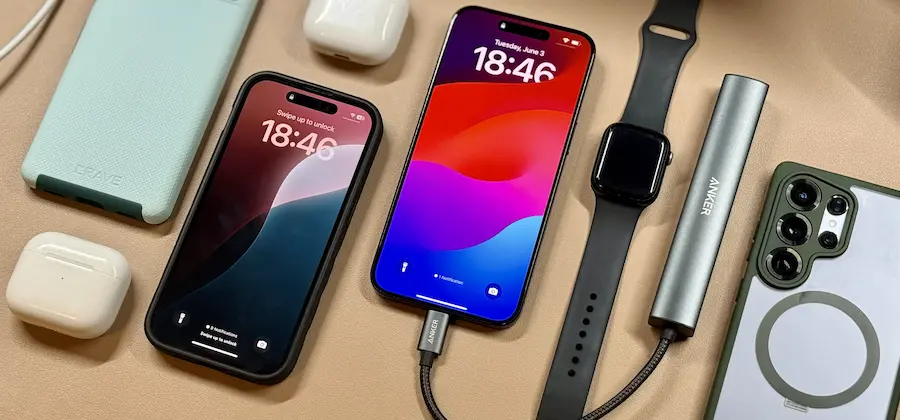Have you ever run out of battery on your headphones or Apple Watch and wished you had a geeky solution at hand? If you have an iPhone with USB-C, you
re in luck! Today on ActualApp we break down how to turn your iPhone into a true charging hub for small gadgets. This feature, which many users overlook, can get you out of more than one tight spot when you
re far from outlets and need to revive your favorite devices. Want to know what you can charge, how to do it and what the limits are? Keep reading to find out everything.
Which iPhone models allow charging other devices?
The magic of reverse charging has arrived to the iPhone family thanks to the introduction of the USB-C port. However, not all models are invited to this tech party: only the iPhone 15, iPhone 15 Plus, iPhone 15 Pro and iPhone 15 Pro Max (and future USB-C models) can share their power with other gadgets. If you have an older Lightning model, unfortunately this functionality is not available. This restriction places the latest iPhones in the same league as Android handsets like Samsung Galaxy devices that have long offered PowerShare for reverse charging, although with important caveats.
What devices can you charge (and which ones not)?
Although the idea of using the iPhone as a power bank is tempting, there are clear limits imposed by the hardware and the maximum output power: up to 4.5 watts. That means its meant for small gadgets: you can charge AirPods (of any generation), your Apple Watch, other smartphones (including another iPhone or even Android), Kindle readers, wireless headphones, portable Bluetooth speakers, compact cameras and fitness bands. It is also possible to connect small power banks to give them extra life.

That said, forget about recharging large tablets like the iPad or laptops: those devices demand much more power than the iPhone can deliver. In fact, if you try to power one of these demanding devices, you
probably only end up draining your phones battery even faster. In short, always think of accessories and devices you would normally charge with a small charger.
Geek tutorial: how to charge other devices with the iPhone
The operation is simple but requires having the proper cables depending on the device you want to charge. If both gadgets have USB-C
s two recent iPhones or a modern Android
then you only need a USB-C to USB-C cable. To charge AirPods or an Apple Watch, you
might need adapted cables: for example, the USB-C magnetic cable for the watch or a USB-C to Lightning for older earbuds or iPhones.
Here
s how to do it:
- Make sure the iPhone is switched on.
- Connect the appropriate cable to the iPhone
s USB-C port. - Connect the other end to the device you want to charge.
- Done! Charging starts automatically.
There are no special on-screen alerts confirming the charge (unlike the classic MagSafe charging icon), so you
have to check the accessory
s screen to verify it. If you have the “Batteries” widget on your home or lock screen and that accessory is paired via Bluetooth, youa
an see its level rise while it charges
although that information arrives via Bluetooth and not via cable.
By the way: if you use a USB-C hub (like popular Anker hubs), you can even charge two devices at once from your iPhone
but remember they will share those 4.5 watts and the speed will drop even more!
Limits, tips and frequently asked questions about reverse charging
Not everything is advantages: using your iPhone as a portable battery involves a noticeable consumption. For example, fully recharging a pair of AirPods can take between 15% and 20% of the iPhones battery; for the Apple Watch the figure rises to 25%. And if you decide to power another smartphone? Be prepared to say goodbye to 50% or more of your autonomy.
Of course, if your phone reaches critical battery levels it will automatically stop supplying power to other devices
the priority will always be self-preservation. And speaking of taking care of your gear: avoid overheating by leaving your iPhone uncovered while charging other devices and don
t use this feature for long periods except in emergencies; we don
t want a smartphone turned into a toaster!
Don
t forget to inspect cables and ports regularly and opt for certified cables like the Thunderbolt 5 USB-C Pro Cable if you
re looking for full compatibility and fewer interferences
yes, those kinds of details make the difference for those of us who love tech. And if something fails (the accessory doesn
t charge), check connections, use original cables whenever possible and make sure both the iPhone and the gadget are switched on.
Despite these limitations, having this function in your pocket turns the iPhone into a sort of “digital multitool” worthy of the Raspberry Pi universe
always ready to lend a hand when you least expect it. Who needs a traditional power bank when you carry a mini power center with you?
.

